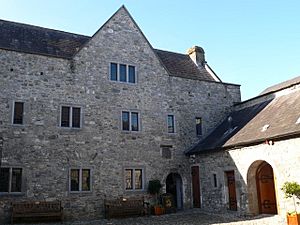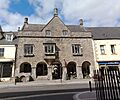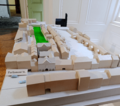Rothe House facts for kids
Quick facts for kids Rothe House |
|
|---|---|
 |
|
| General information | |
| Type | Merchant townhouse |
| Architectural style | English Renaissance style |
| Address | Parliament Street |
| Town or city | Kilkenny |
| Country | Ireland |
| Coordinates | 52°39′17″N 7°15′18″W / 52.654709°N 07.254954°W |
| Construction started | 1594 |
| Completed | 1610 |
| Owner | Kilkenny Archaeological Society |
Rothe House is a special old house complex in Kilkenny, Ireland. It was built a long time ago, in the late 1500s, by a rich merchant named John Rothe Fitz-Piers. The complex is actually made up of three houses, three enclosed yards, and a big garden. Today, it's a museum that you can visit!
Rothe House is very important because it's the only place in Ireland that still has a complete "burgage plot." This means the original land and buildings from that time are still mostly unchanged. The Kilkenny Archaeological Society owns Rothe House. They keep many old items from Kilkenny City, County, and Ireland there.
The garden behind the house has been rebuilt to look like a garden from the 1600s. It even has a well that was dug by monks a long time ago! Part of Kilkenny's old city wall is also connected to the Rothe House complex.
History of Rothe House
The Rothe family were important merchants. They also took part in local politics. They were part of a small group of powerful families. These families controlled Kilkenny for many years, from the 1400s to the 1600s. John Rothe Fitz-Piers built Rothe House on a piece of land he bought.
Each of the three houses has a date showing when it was built. The first house is dated 1594. You can see this date on John Rothe's family crest. The second house has the date 1604. The third house, built in 1610, has the Rothe-Archer family crest above its door.
John Rothe is buried in the old St. Mary's Church. He planned his own tomb in his will in 1619.
The Rothe family lost their house for a while. This happened after King Charles I was defeated in England. The family was involved in a group called the Confederation of Kilkenny. It's thought that one of their meetings happened at Rothe House. Later, when King Charles II became king, the house was given back to the Rothe family. But they lost it again after the Battle of the Boyne. The house was owned by different people over the years. Finally, the Kilkenny Archaeological Society bought it in 1962.
For over 100 years, until 2015, the second house was used by the Gaelic League. This group promotes the Irish language and culture. Thomas MacDonagh taught Irish history there. One of the rooms is now named after him. Other rooms are named after women who were important members of the Kilkenny Archaeological Society.
Architecture and Design
Rothe House shows what a rich merchant's home looked like in Kilkenny. It was built in the English Renaissance style. This style became popular in Ireland in the 1560s.
John Rothe built his three houses one after another. The first was in 1594, the second in 1604, and the third in 1610. It's interesting that he built three separate houses. He didn't just make the first house bigger for his growing family. He followed a building style that his wife's family, the Archers, also used.
Other old houses in Kilkenny from the same time include 'The Hole in the Wall' and the Shee Alms House. These buildings help us understand what Kilkenny looked like hundreds of years ago.
Rothe House Museum
The museum at Rothe House has many old items. These include archaeological finds and historical objects. Most of them were found in the local area. Many were also given to the Kilkenny Archaeological Society by people from Kilkenny.
Images for kids











